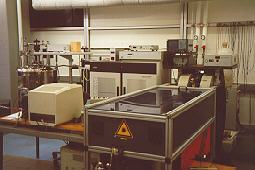EPR Spectroscopy (ESR 1)
Methods IPC, Weber
| EPR Sepctroscopy (ESR 1) | Model: | Bruker E680W/X |
| Unit and Room: | Physical Chemistry, 5th floor, R. 503b |
|
| Responsible: | Prof. Dr. Stefan Weber |
|
| Electron Paramagentic Resonance (EPR) | Further information: | http://www.physchem.uni-freiburg.de/ akweber/forschung/eprfolder/ index.html |
| Short Description: Continous-wave/pulsed EPR-Spectrometer operating at X-band (9–10 GHz) and W-band (94–96 GHz) microwave frequencies. |
Picture of the Equipment
|
|
| Available Experiments/Techniques: all currently available pulsed and continuous-wave methods, including pulsed electron–nuclear double resonance (ENDOR), pulsed electron–electron double resonance (PELDOR, DEER), and transient EPR (TREPR) |
||
| Special Equipment: Low temperature unit (cryostat/resonator) for temperature range from 5 to 300 K. |
||
| Measurements on the equipment are currently done by: | Students after extensive training Trained scientific service personal |
|
| Recent Publications, where this instrument was important (citation): |
FEBS J. 276 (2009) 4290–4303; J. Phys. Chem.B 112 (2008) 3568–3574 |
|
| Typical problems that may be solved with this instrument: | – identification of radicals – electronic structure determination of paramagnetic centers (organic radicals, transition metal ions, defect centers, optically excited states (triplets, radical pairs)) – distance measurements between two paramagnetic centers – determination of hyperfine couplings, dipolar and exchange interaction parameters, g-tensors, quadrupole tensors |
|
![]() EPR Spectroscopy (ESR 1) (this page as a pdf file)
EPR Spectroscopy (ESR 1) (this page as a pdf file)


